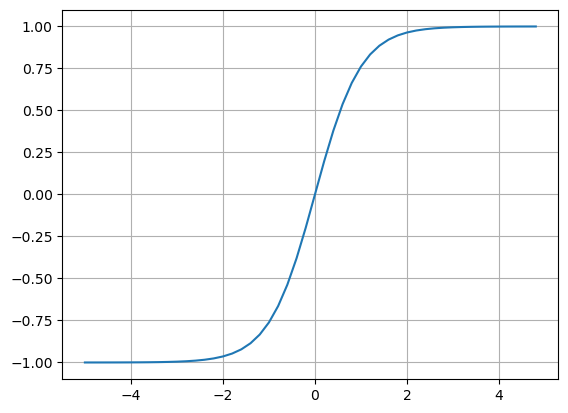Understanding backpropogation
In this post, we will implement backpropogation using elementary arithmetic operations [colab] [repo]
We also recommend cloning the original micrograd repository by Andrej Karpathy [1] [2]. The approach in micrograd is modeled after the dynamic computational graph of Pytorch [3], with the mindset of getting to a operationally minimal implementation of backpropogation. This post is not a guide on training neural networks or the numerous subtleties associated with training. It is meant to be short introduction to automatic differentiation.
We start with a few basic imports:
import math
import numpy as np
import matplotlib.pyplot as plt
We now define the Value class which forms the heart of micrograd:
class Value:
""" stores a single scalar value and its gradient """
def __init__(self, data, _children=(), _op='', label=''): #__init__(object, data, attributes)
self.data = data
self.grad = 0.0
self._backward = lambda: None
self._prev = set(_children)
self._op = _op
self.label = label
def __repr__(self):
return f"Value(data={self.data})"
def __add__(self, other):
other = other if isinstance(other, Value) else Value(other)
out = Value(self.data + other.data, (self, other), '+')
def _backward():
self.grad += 1.0 * out.grad
other.grad += 1.0 * out.grad
out._backward = _backward
return out
def __mul__(self, other):
other = other if isinstance(other, Value) else Value(other)
out = Value(self.data * other.data, (self, other), '*')
def _backward():
self.grad += other.data * out.grad
other.grad += self.data * out.grad
out._backward = _backward
return out
def __pow__(self, other):
assert isinstance(other, (int, float)) # only supporting int/float powers for now
out = Value(self.data**other, (self,), f'**{other}')
def _backward():
self.grad += (other * self.data**(other-1)) * out.grad
out._backward = _backward
return out
def __truediv__(self, other): # self / other
return self*other**-1
def __neg__(self): # -self
return self * -1
def __sub__(self, other): # self - other
return self + (-other)
def __rmul__(self, other): # other * self
return self * other
def __radd__(self, other): # other + self
return self + other
def __rsub__(self, other): # other - self
return other + (-self)
def __rtruediv__(self, other): # other / self
return other * self**-1
def tanh(self):
x = self.data
t = (math.exp(2*x) - 1)/(math.exp(2*x) + 1)
out = Value(t, (self,), 'tanh')
def _backward():
self.grad += (1 - t**2) * out.grad
out._backward = _backward
return out
def exp(self):
x = self.data
out = Value(math.exp(x), (self,), 'exp')
def _backward():
self.grad += out.data * out.grad
out._backward = _backward
return out
#pow, truediv
def backward(self):
#topological sort
topo = []
visited = set()
def build_topo(v):
if v not in visited:
visited.add(v)
for child in v._prev:
build_topo(child)
topo.append(v)
self.grad = 1.0
build_topo(self)
for node in reversed(topo):
node._backward()
# implements in order: o._backward(), nn._backward(), x1w1x2w2._backward(), x2w2._backward(), x1w1._backward()
Basically, the Value class defines python’s elementary arithmetic operations (like add, multiply, divide) for a computational graph represented as a tree data structure: the root node of the tree signifies the neural net output, and leaf nodes signify the input data vector along with first-layer weights. In addition, it includes rules for local gradient updates in $\texttt{_backward()}$ and a full-graph gradient update in $\texttt{backward()}$. The full-graph gradient update combines $\texttt{_backward()}$ with a topological sort approach to traversing the graph from output to input nodes. The main non-elementary differentiable operation it contains is tanh, which is to be used as the nonlinear activation function at each node.
We now include a graphviz code like Andrej does, that is capable of visualizing such a computational graph diagrammatically
from graphviz import Digraph
def trace(root):
nodes, edges = set(), set()
def build(v):
if v not in nodes:
nodes.add(v)
for child in v._prev:
edges.add((child, v))
build(child)
build(root)
return nodes, edges
def draw_dot(root, format='svg', rankdir='LR'):
"""
format: png | svg | ...
rankdir: TB (top to bottom graph) | LR (left to right)
"""
assert rankdir in ['LR', 'TB']
nodes, edges = trace(root)
dot = Digraph(format=format, graph_attr={'rankdir': rankdir}) #, node_attr={'rankdir': 'TB'})
for n in nodes:
dot.node(name=str(id(n)), label = "{ %s | data %.4f | grad %.4f}" % (n.label, n.data, n.grad), shape='record')
if n._op:
dot.node(name=str(id(n)) + n._op, label=n._op)
dot.edge(str(id(n)) + n._op, str(id(n)))
for n1, n2 in edges:
dot.edge(str(id(n1)), str(id(n2)) + n2._op)
return dot
The code above can basically draw the entire graph, and indicate label, data, & gradient information at each node. The gradient at each node $j$ (as computed in value class) is the partial derivative of the loss function $L(o(\boldsymbol x_{in},\boldsymbol w),y_{in})$ w.r.t. the weight $w_j$ at that node, so that’s $\frac{\partial L(o(\boldsymbol x_{in},\boldsymbol w),y_{in})}{\partial w_j}$. Explaining the notation: $\boldsymbol x_{in}$ is the input data sample vectorized, $\boldsymbol w$ are the weights vectorized, $o(\cdot)$ computes the network output for the input sample and label, $L(o(\cdot),y_{in})$ computes the loss function for the output and label.
As such, the neural network output is simply $o(\boldsymbol x_{in},\boldsymbol w)$. The loss function is an additional step computing a metric function on the output and supervised output labels of the training data. The mean-squared loss (2-norm) is a simple example: $\lVert o(\boldsymbol x_{in},\boldsymbol w) - \boldsymbol l \rVert_{2}$, where weight vector $\boldsymbol w$ is known to produce a scalar output $l$, and the 2-norm (mean squared loss) is only really sensible in the limit of multiple outputs (so that $\boldsymbol o$ and $\boldsymbol l$ become vectors)
Just out of curiosity, the hyperbolic tangent is plotted to visualize its nonlinearity:
plt.plot( np.arange(-5,5,0.2), np.tanh(np.arange(-5,5,0.2)) ); plt.grid()

In what follows, a simple two-input neuron is initialized via the value class:
x1 = Value(2.0,label='x1')
x2 = Value(0.0,label='x2')
w1 = Value(-3.0,label='w1')
w2 = Value(1.0,label='w2')
b = Value(6.88137358,label='b')
x1w1 = x1*w1; x1w1.label = 'x1*w1'; print(x1w1)
x2w2 = x2*w2; x2w2.label = 'x2*w2'; print(x2w2)
x1w1x2w2 = x1w1 + x2w2; x1w1x2w2.label = 'x1*w1 + x2*w2'; print(x1w1x2w2)
nn = x1w1x2w2 + b; nn.label = 'nn'; print(nn)
o = nn.tanh(); o.label = 'o'; print(o)
Value(data=-6.0)
Value(data=0.0)
Value(data=-6.0)
Value(data=0.88137358)
Value(data=0.707106777676776)
and then the gradients are backpropogated using the $\texttt{backward()}$ function in value class, and visualized using the $\texttt{draw_dot()}$ function defined in the graphviz section earlier:
o.backward()
draw_dot(o)

Now, just as an extra exercise in object oriented programming, the tanh function is further broken down as $\tanh(x) = \frac{e^{2x} + 1}{e^{2x} - 1}$ and we implement it as a composite function of exponentiation, addition (subtraction), division. Division in the value class is implemented more generally as a composite of multiplication and monomials: $\frac{a}{b} = a*b^{-1}$, so implement $\texttt{pow()}$ in value class so that we can more generally produce monomials $x^n$ of arbitrary degree in our arithmetic system.
Once the above steps are implemented in the value class, we can now produce a longer computational graph and verify that we still get the same gradients:
#after implementing pow, truediv, exp
# inputs x1, x2
x1 = Value(2.0,label='x1')
x2 = Value(0.0,label='x2')
# weights w1, w2
w1 = Value(-3.0,label='w1')
w2 = Value(1.0,label='w2')
# neuron bias
b = Value(6.88137358,label='b')
x1w1 = x1 * w1; x1w1.label = 'x1*w1'; print(x1w1)
x2w2 = x2 * w2; x2w2.label = 'x2*w2'; print(x2w2)
x1w1x2w2 = x1w1 + x2w2; x1w1x2w2.label = 'x1*w1 + x2*w2'; print(x1w1x2w2)
nn = x1w1x2w2 + b; nn.label = 'nn'; print(nn)
ee = (2 * nn).exp(); print(ee)
o = (ee - 1) / (ee + 1)
o.backward()
draw_dot(o)
Value(data=-6.0)
Value(data=0.0)
Value(data=-6.0)
Value(data=0.88137358)
Value(data=5.828427042920401)

We now shift focus to being able to achieve the same with Pytorch: the most popular deep learning library. In the process, we can verify the functional equivalence of micrograd’s and Pytorch’s $\texttt{backward()}$ functions:
# single two-param neuron backprop in pytorch
import torch
x1 = torch.Tensor([2.0]).double() ; x1.requires_grad = True
x2 = torch.Tensor([0.0]).double() ; x2.requires_grad = True
w1 = torch.Tensor([-3.0]).double() ; w1.requires_grad = True
w2 = torch.Tensor([1.0]).double() ; w2.requires_grad = True
b = torch.Tensor([6.8813735]).double() ; b.requires_grad = True
n = x1*w1 + x2*w2 + b
o = torch.tanh(n)
print(o.data.item())
o.backward()
print('---')
print('x2', x2.grad.item())
print('w2', w2.grad.item())
print('x1', x1.grad.item())
print('w1', w1.grad.item())
0.7071066904050358
---
x2 0.5000001283844369
w2 0.0
x1 -1.5000003851533106
w1 1.0000002567688737
That’s it from me! I’m skipping the part where Andrej discusses the $\texttt{nn.py}$ classes, as that’s primarily linguistic abstractions. The core mathematics is automatic differentiation on computational graphs. Backpropogation is simply a special case where such an autograd engine is applied to an “ansatz” of nonlinear functions we call neural networks. Have a wonderful day!
Roughwork:
a = Value(2.0)
b = Value(4.0)
a / b
Value(data=0.5)
a = Value(3.0, label='a')
b=a+a; b.label = 'b'
b.backward()
draw_dot(b)

a = Value(-2.0, label='a')
b = Value(3.0, label='b')
d = a * b ; d.label = 'd'
e = a + b ; e.label = 'e'
f = d * e ; f.label = 'f'
f.backward()
draw_dot(f)

a = Value(2.0)
2 * a
Value(data=4.0)
References
[1] Github: Micrograd by Andrej Karpathy
[2] Youtube: Lecture by Andrej Karpathy
[3] GeeksforGeeks: Computational Graphs
